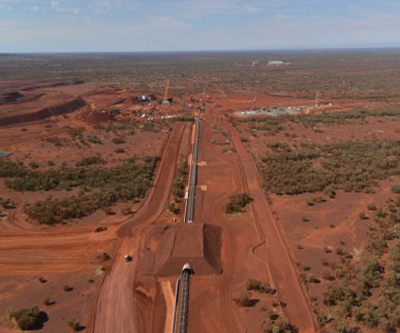
Benchmark iron ore was was exchanging hands for $54.50 a tonne on Thursday – a level it’s hardly strayed from for the past two months.
In the mid-50s it’s technically in a bull market, gaining more than 20% from record lows for the spot market of just over $44 a tonne hit July 8 according to The Steelindex.
Compared to this time last year however, the steelmaking ingredient has more than halved in value.
Ore’s stability amid amid wild price swings in other metals – notably copper – in recent weeks has been noteworthy.
But a new report by CitiGroup says miners have to prepare for a new gap down in price.
And Roy Hill can take most of the blame.
New supply from Gina Rinehart’s project in the Pilbara will contribute to a slump below $40 a tonne in the first half of next year according to the investment bank.
Last year, Roy Hill received the biggest ever financing package for a mining project anywhere the world according to Rinehart’s Hancock Prospecting, and at fill tilt will ship 55 million tonnes a year starting this month.
A price below $40 all-in makes life difficult for all but the most cost-effective producers and as this chart shows Roy Hill is yet another ultra-low cost producer entering the market:

Source: UBS via Bloomberg
As if the arrival of Roy Hill is not enough for faltering steel demand to absorb, other news out this week is bound to add even more pressure.
Top producer Vale said that the giant expansion of its Carajas complex in northern Brazil that goes by the innocuous moniker of S11D is ahead of schedule will be completed before December next year.
S11D will add an additional 90 million tonnes to global supply. At least the Rio de Janeiro-based company says it “will control the speed” at which the ore hits the market.
Smaller iron ore miners not only have to compete with majors but now there could be a new game in town – Chinese scrap.
A new research report by Minerals Value Service shows the price to a Chinese coastal mill of producing one tonne of pig iron is currently higher than benchmark scrap price inside the country.
While it may take a while for China’s blast furnaces to retool to take advantage of increased levels of cheap scrap, 90% Fe feedstock would be preferable over iron ore in an industry that’s been plagued by unprofitability for years.
2 Comments
Altaf
Steel scrap can be directly fed to Electric Arc Furnace in place of Pig Iron. This takes out the need to have Blast furnace in the first place. The effect is one ton of scrap takes out the need to import 1.6 tons of 62% Fe ore.
PaoloUSA
Another outdated unsustainable business model project. In the iron ore business they simply do not learn aside from being chronically few years back with respect to market trends. The financing institutions appears to be on the same wavelength of never learning about sustainability, I wonder for someone that pushes for immigrants to work for less than 2000$/months…………..Volkswagen will teach a good lesson.